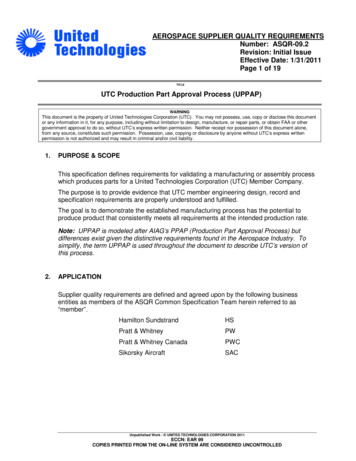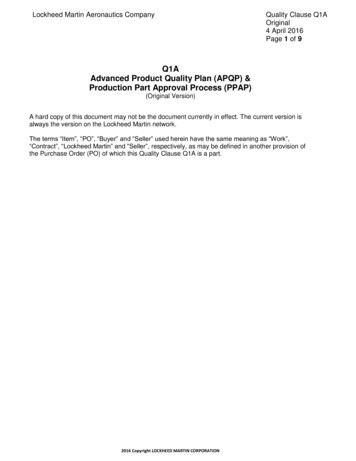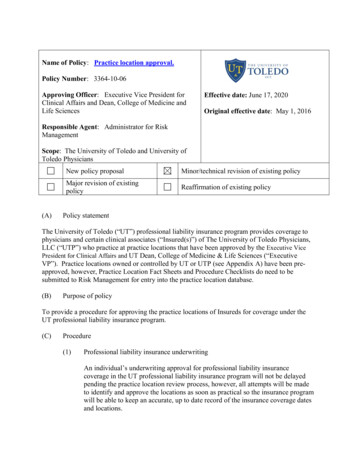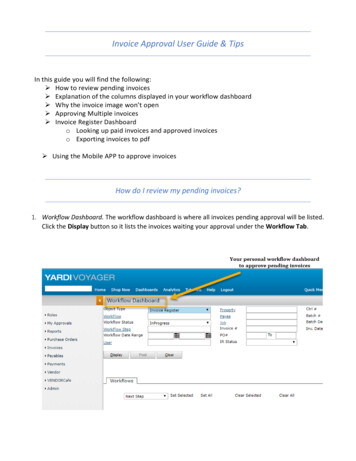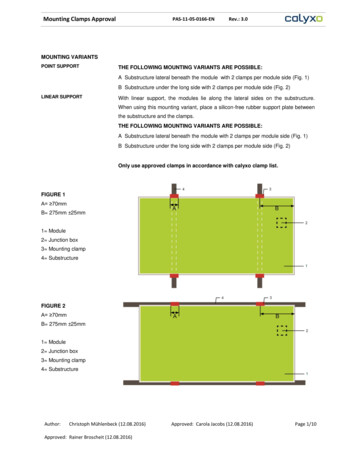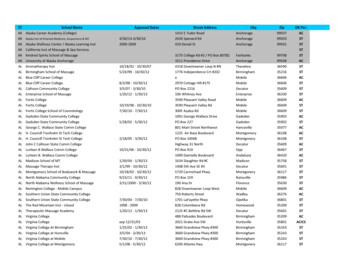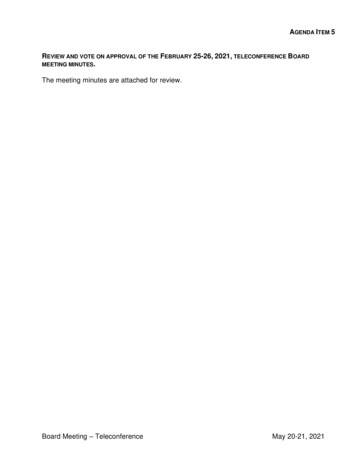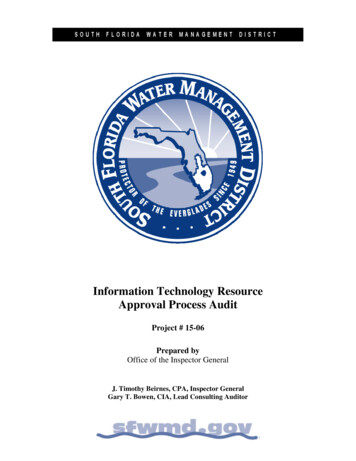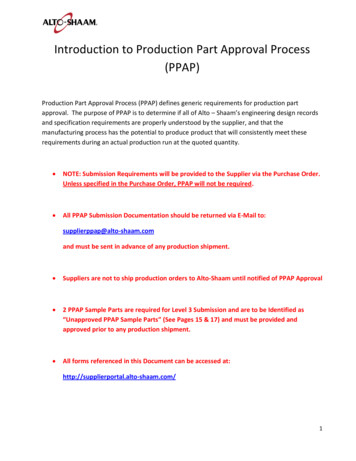
Transcription
Introduction to Production Part Approval Process(PPAP)Production Part Approval Process (PPAP) defines generic requirements for production partapproval. The purpose of PPAP is to determine if all of Alto – Shaam’s engineering design recordsand specification requirements are properly understood by the supplier, and that themanufacturing process has the potential to produce product that will consistently meet theserequirements during an actual production run at the quoted quantity.NOTE: Submission Requirements will be provided to the Supplier via the Purchase Order.Unless specified in the Purchase Order, PPAP will not be required.All PPAP Submission Documentation should be returned via E-Mail to:supplierppap@alto-shaam.comand must be sent in advance of any production shipment.Suppliers are not to ship production orders to Alto-Shaam until notified of PPAP Approval2 PPAP Sample Parts are required for Level 3 Submission and are to be Identified as“Unapproved PPAP Sample Parts” (See Pages 15 & 17) and must be provided andapproved prior to any production shipment.All forms referenced in this Document can be accessed at:http://supplierportal.alto-shaam.com/1
Supplier Quality ManagementProduction Part Approval ProcessRevision 1July 18, 20132
IntroductionThe Alto – Shaam Purchasing staff has prepared this guide for new and existingsuppliers of raw material and components to Alto – Shaam. Its purpose is to definethe approval process of new or revised parts, or parts that are from new orsignificantly revised production methods. As a Supplier, it is your responsibility toensure that you ship only parts that have been approved and meet Alto – Shaamspecifications.If you have questions regarding the contents or processes described in this guide,please contact the Supplier Development Engineer representative of Alto – Shaam at1-800-558-8744.For further information about the contents of this guide, please refer to theAutomotive Industry Action Groups (AIAG) Production Part Approval Process (PPAP).3
Production Part Approval Process (PPAP)PurposeThe purpose of the Production Part Approval Process (PPAP) is: To provide evidence that all Alto – Shaam engineering design records and specificationrequirements are properly understood and fulfilled by the supplying organization. To demonstrate that the established manufacturing process produces product that consistentlymeets all requirements during an actual production run.When is PPAP Submission Required?In general PPAP is required anytime a new part or a change to an existing part or process is beingimplemented. It is at the discretion of Alto – Shaam to determine whether PPAP will be required.As a supplier to Alto – Shaam your quality system should be capable of meeting the requirements of thePPAP submission regardless of whether you have been asked for a submission.Alto – Shaam reserves the right to request a PPAP submission for a variety of reasons including:1.2.3.4.5.6.7.New PartNew SupplierEngineering ChangeNew ProcessNew or Change to supplier manufacturing locationNew or modified ToolsMaterial changeElements of Alto – Shaam PPAP SubmissionAlto – Shaam’s PPAP submission requirements are a sub-set of the existing AIAG standard. One or more ofthe following may be required as part of the submission, depending upon the assigned submission level.1.2.3.4.5.6.7.8.9.Part Submission Warrant (Alto – Shaam Part Submission Form only)Design Records (& Bubbled Drawings)Process Flow DiagramProcess Failure Mode & Effects AnalysisControl PlanDimensional Results (Alto – Shaam format or equivalent)Records of Material/Performance Test ResultsInitial Process StudiesSample Production PartsAlto – Shaam has forms available at: http://supplierportal.alto-shaam.com/ . You can use those or anyAIAG compliant form with the exception of Element 1, Part Submission Warrant.4
Submission LevelsSubmission Levels define which elements are required to be submitted. The levels are used for differentreasons and applications and are defined by Alto – Shaam. There are three submission levels. The Level ofsubmission required will be communicated via the Purchase Order:Level 1Part Submission Warrant only.Level 2Part Submission Warrant with limited supporting documentation.Level 3Part Submission Warrant with product samples and complete supportingdocumentation.Regardless of Submission Level, all PPAP submissions must be sent in advance of any productionshipments.As specified by the Purchase Order, a PPAP submission will be required for each Part Number.5
Submission Requirements Quick Reference Guide1Design Records &Bubbled part print(s)3Process Flow Diagram4Process Failure Mode &Effects Analysis (PFMEA)5Level 3Part Submission WarrantS2Level 2PPAP RequirementsReference AIAG PPAPElementFourth Edition Important:OrderSubmit your documentsin this orderLevel 1Alto – Shaam has a Quick Reference Guide that can be used for referencing and organizing a PPAPsubmission. The Reference Guide lists all of the required elements for each Submission Level, 1 through 3.SSN/A SSN/A N/A SN/A N/A SControl PlanRequired DocumentsAlto - Shaam Part Submission Form onlyAdditional CommentsAlto - Shaam PSW is required for all submissions and is required for all Alto Shaam designed parts.Alto - Shaam Part PrintInclude one clean copy of the current approved revision print with alldimensions, applicable specifications, and notes, bubbled (circled withcorresponding number) on the print for reference to the dimensional report.Any Standard flowchart formatIndentifies all process steps from receiving to shipping. Process steps mustmatch PFMEA and Control Plan steps.Can be Alto - Shaam supplied format or anAIAG compliant PFMEA.Process steps must match Process Flow Chart, Control Plan and address allcharacteristics associate with each operation. Risk Priority Numbers mustbe identified with critical processes and inspections identified.Can be Alto - Shaam supplied format or anAIAG compliant Control Plan.Control Plan must match the Flow Chart and PFMEA process steps anddescribe the actions of each phase of the manufacturing process fromreceiving to shipping. All Critical Characteristics must be addressed withinthe corresponding process step. Any dedicated check/testing fixtures that areused will be identified along with the numbered characteristic itmeasures/tests on the printInclude all characteristics on the print. Report results should correspond tothe "Bubbled" dimensions of the Print and be reported in the same scale asthe Print. Results of 3 parts is required (if parts are from a Multi-Cavitiy tool,report results for 1 piece per cavity, and note cavity).N/A N/A S678Dimensional ResultsRecords of Material /Performance Test ResultsN/A SSN/A SSIndustry Standard ReportsInitial Process StudiesN/A *9Sample Production PartsCan be Alto - Shaam supplied format orsimilar.*N/A N/A SCertificates of Analysis for all primary raw materials such as steel, rubber,chemicals, and plastic resins. Performance life testing results, such as SaltSpray, heat, electrical performance, when required by Print or Specification.Capability Study using any statistical package A short term study of process capability must come from a significantor Alto - Shaam supplied format.production run. For Critical Characteristics a minimum Cpk value of 1.33 isrequired. For Multi-cavity tools, a separate study is required for each cavity.Parts Tagged "PPAP Samples"2 sample parts with every submission unless otherwise requested. Multicavity tools require 1 part per cavity.S Submission to Alto – Shaam RequiredElectronic SubmissionAlto – Shaam prefers that all PPAP submissions be submitted electronically via e-mail to:supplierppap@alto-shaam.comIt is preferred that the PPAP be 1 PDF file for the entire submission.6
Significant Production RunPPAP data is generally submitted from a “significant production run”, sampled randomly.–Sampling should be taken from a representative production run, utilizing production equipment,tooling and production employees.The intent is that all data reflects the actual production process to be used during production.Submission StatusThe review and approval of the PPAP submission will be managed by Alto – Shaam. Submissions will bereviewed and dispositioned with one of the following statuses:Approved: Acceptance of the PPAP submission within the specified guidelines set forth by Alto – Shaam.Rejected: The PPAP submission does not meet the specified guidelines and must be resubmitted forapproval.Interim Approval: An interim approval may be given through an agreement with Alto – Shaam engineering,and the product must not affect final product quality. Interim approval is limited to a defined number ofdays or quantity, and a corrective action plan must be identified to achieve full approval.Critical To Quality (CTQ)Critical To Quality characteristics are defined as: A critical part requirement specified on the engineering document, typically a drawing, specificationor performance requirement. A critical process requirement that is identified by Alto – Shaam, i.e. Welding.Critical Characteristics are features that have greater significance and most affect the outcome of a productor process. Alto – Shaam expects suppliers to address all CTQ’s in the Control Plan and that robust processcontrols are in place to ensure product conformance. Control may require the supplier to performcapability studies or implement Poke – Yoke (mistake proofing) techniques. Alto – Shaam will identifyCTQ’s in one of two manners. Either an Oblong or Rectangle will bound a feature of the design record.3.327 [84.52]90.0 7
Instructions for completing a PPAP SubmissionAll submissions must be submitted no later than the PPAP Due Date indicated on the Purchase Order.All Submissions should be sent via E-Mail to: supplierppap@alto-shaam.comElement 1- Part Submission Warrant (PSW)The purpose of the Part Submission Warrant is to document the submission and the approval or rejectionof purchased parts prior to production.Alto – Shaam has developed its own Submission Warrant document and this form is a required element ofthe PPAP submission. It must be submitted as part of the PPAP and is required for every Level, 1, 2, or 3.The form must be submitted with the correct Part Number, Revision Level and to the proper Submissionlevel. It is critical to make sure the Warrant is filled out correctly, and contains accurate and legibleinformation.8
Element 2 Design Records and “Bubbled” DrawingsThe purpose of the Design Record and Bubbled Drawings is to document and provide a copy of the partprint and any other additional engineering records.Example of a Bubbled Drawing (see below)A bubbled drawing shows the parts in a part print with numbered “bubbles” that point to individualdimensions and requirements of the part. The numbers on the bubbled drawing correspond to thenumbers found on the Dimensional Results form.SUPPLIER:PART NUMBER:PART NAME:NAME OF TECHNICIAN NGINEERING CHANGE LEVELSPECIFICATION /LIMITSMEASUREMENTTECHNIQUE (Gage)TESTDATEQTYTESTEDORGANIZATION MEASUREMENT RESULTS (DATA)OKNOTOKAll Part requirements on the print must be bubbled and numbered for reference and measurement, andmay include: Dimensions, electrical requirements, visual features (color, finish, etc).9
Element 3 Process Flow DiagramThe purpose of the Process Flow Diagram is to document the steps required in the manufacturing of thepart. The Main process steps must match both the Process Failure Mode & Effects Analysis, and theControl Plan. The Process Flow should include the entire process, from Receiving through Shipping.The Process Flow Diagram must include all key steps of the process and include activities, such as,Inspection, Measurement, Scrap, and disposition of Non-Conforming material.10
Element 4 Process Failure Mode & Effects Analysis (PFMEA)The Process FMEA (PFMEA) is used to show evidence that any potential failures and risks have beenevaluated for the manufacturing process. PFMEA’s can be submitted using the Alto – Shaam form orsimilar.A PFMEA should be performed for every part, or process involved in manufacturing. The PFMEA should bedeveloped in a Cross Functional manner, involving participation from engineering, quality, purchasing, etc.The PFMEA worksheet is used as a tool to identify and show potential process risks (or what could gowrong) with the manufacture of each part. It also indicates the controls with each process. All high RiskPriority Numbers (RPN) resulting from the PFMEA should be carried over to the Control Plan.Sample of PFMEA form belowPOTENTIAL FAILURE MODE AND EFFECTS ANALYSIS (PROCESS FMEA)PART NUMBERTEAM MEMBERSFMEA #REVISION #DATEAPPROVED BYPOTENTIALFAILURE MODEPROCESS FUNCTIONPOTENTIALEFFECT OFFAILURESEVERITYACTION RESULTSCLASSPOTENTIAL CAUSEOF FAILUREOCCURCURRENT CTIONRESPONSIBILITY& CURRISKPRIORITYNUMBERSample of steps of the PFMEAPOTENTIAL FAILURE MODE AND EFFECTS ANALYSIS (PROCESS FMEA)PART NUMBERTEAM MEMBERS5011234John Doe, Mary Smith, Donald Brown, Sam JonesAPPROVED BYSam JonesPROCESSFUNCTION010PROCESS FUNCTIONPOTENTIALFAILURE MODEPOTENTIALEFFECT OFFAILUREmaterial does notReceive Incoming meetfailure ofmaterialspecificationcorrosion testSEVERITY7FMEA #REVISION #DATEACTION RESULTSCLASSPOTENTIAL CAUSEOF FAILURESupplier sentw rong materialOCCUR2wrong tool used020030machiningblankingoversizeddiameterpart fails to fitor mate8001A1/5/2013wrong programenteredCURRENT PROCESSCONTROLmaterial certificationsw ith each 84none348Automatic Toolretrieval systemRESPONSIBILITY TECTRISK PRIORITYNUMBERAdd last pieceinspectionand keep finalpiece withTool8118first piece inspection2first piece inspectionimproper use ofgageoperator trainingout of calib
Automotive Industry Action Groups (AIAG) Production Part Approval Process (PPAP). 4 Production Part Approval Process (PPAP) Purpose The purpose of the Production Part Approval Process (PPAP) is: To provide evidence that all Alto – Shaam engineering design records and specification requirements are properly understood and fulfilled by the supplying organization. To demonstrate that

